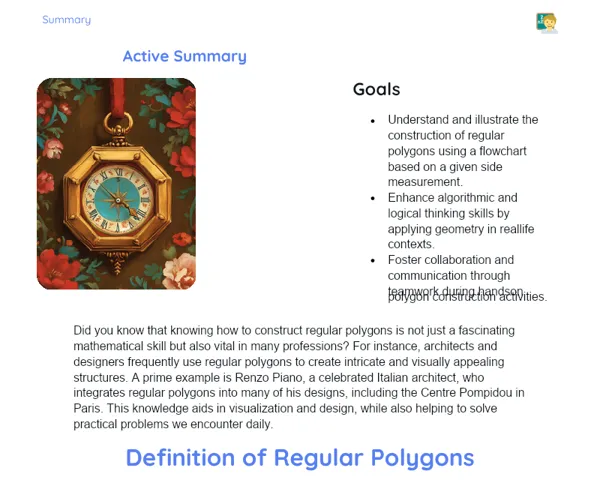Objectives
1. 🎯 Identify and count the number of vertices, faces, and edges of 3D shapes like pyramids and prisms, thereby sharpening logical reasoning and spatial visualization skills.
2. 🌟 Develop a clear understanding of the structure and properties of geometric solids, which is crucial for practical applications in areas like engineering and design.
3. 🤝 Foster teamwork and collaboration through engaging hands-on activities that apply mathematical concepts in real-world contexts.
Contextualization
Did you know that geometric solids are essential not only in mathematics but also in fields like architecture and engineering? From the ancient pyramids of Egypt to the towering skyscrapers we see today, understanding the structure and properties of these solids has always been key. In this lesson, we will delve into the significance of three-dimensional shapes in creating sturdy and visually appealing structures, emphasizing the role of each vertex, face, and edge in our physical world.
Important Topics
Vertices
Vertices are the points where the edges of a geometric solid come together. They are vital for defining the shape and structure of the solid. For example, in a cube, each vertex is formed by the intersection of three edges, and all vertices are the same, contributing to the cube's symmetry.
-
Each geometric solid has a distinct number of vertices that uniquely defines its shape. For instance, a cube has 8 vertices.
-
Grasping the concept of vertices enhances spatial visualization and aids in understanding how solids are built.
-
In practical fields like architecture and design, knowing the location of vertices is essential for ensuring the stability and aesthetics of structures.
Faces
The faces of a geometric solid are the flat surfaces that enclose its internal space. Take a cube, for instance; it has six faces, each shaped like a square. The faces are crucial for understanding the topology of the solid and its practical applications.
-
Every face of a geometric solid contributes to the overall face count, which helps define the solid.
-
Faces can vary in shape, such as squares, rectangles, or triangles, which is important for creating intricate designs.
-
Understanding face properties, like area and orientation, is essential for calculating areas and volumes, which is vital in science and engineering.
Edges
Edges are the lines that form the boundary between two faces of a geometric solid. In a cube, for instance, each of the 12 edges connects two vertices and marks the intersection of two faces. Edges are critical for the structure and integrity of solids.
-
The number of edges is distinctive for each type of geometric solid, helping to differentiate them.
-
Edge properties, such as length and orientation, are crucial in applications ranging from manufacturing objects to computer modeling.
-
Understanding edges is vital for tackling problems related to the movement and interaction of solids, such as in mechanics or simulations.
Key Terms
-
Vertices: Points where the edges converge in a geometric solid.
-
Faces: Flat surfaces that enclose the internal space of a solid.
-
Edges: Lines that delineate the boundary between two faces of a solid.
For Reflection
-
How can alterations in the number of vertices, faces, or edges influence the properties and applications of a geometric solid?
-
In which ways can knowledge of vertices, faces, and edges aid in resolving everyday challenges or in engineering and architectural projects?
-
What is the significance of comprehending the relationship between vertices, faces, and edges for advancements in technologies such as 3D printing and computer modeling?
Important Conclusions
-
We reviewed the significance of geometric solids and their foundational role in comprehending and applying mathematical principles across various fields like engineering and architecture.
-
We explored the characteristics of vertices, faces, and edges, underscoring their importance in the structure and design of solids, as well as their application in the real world.
-
We illustrated how knowledge of geometric solids is practical and influences our everyday lives, from packaging products to constructing complex buildings.
To Exercise Knowledge
- Create Your Own Solid: Gather recyclable materials like popsicle sticks and clay to build a geometric solid of your choice, identifying its vertices, faces, and edges. 2. Solid Journal: Select an object at home shaped like a geometric solid and journal about what you learned regarding the properties of that solid. 3. Mystery Solid Challenge: Have a family member hide an object that is a geometric solid. Using clues regarding vertices, faces, and edges, try to identify it.
Challenge
🚀 Solid Builder Challenge: With guidance from an adult, attempt to construct a three-dimensional model of your house using cardboard, incorporating the principles of vertices, faces, and edges that we discussed. Document the process with photos and share your experience and learning with us!
Study Tips
-
Use 3D modeling apps or virtual building games to engage with and manipulate geometric solids in an enjoyable and interactive manner.
-
Watch the recommended videos and supporting materials for this lesson, focusing on the applications of geometric solids in various fields like science and technology.
-
Form study groups to discuss and solve challenges related to geometric solids, supporting each other's understanding and enhancing problem-solving skills.



